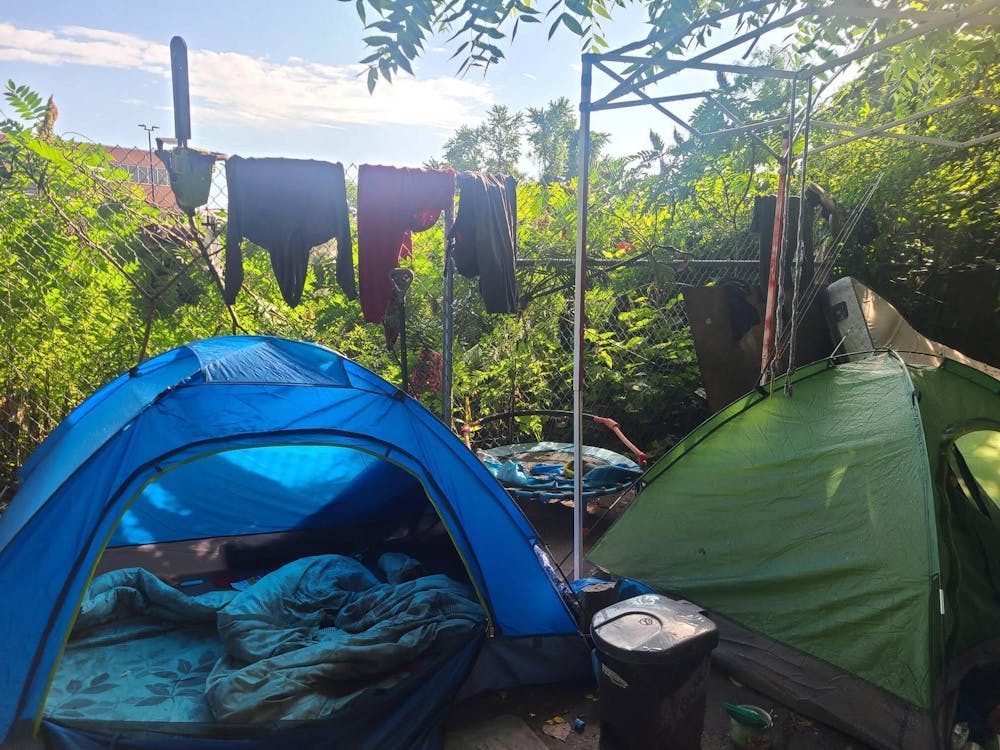On Oct. 13, Gov. Dan McKee and Rhode Island Housing Secretary Stefan Pryor announced the state’s winter strategy to address homelessness. The strategy includes adding 318 beds to the shelter system — a 30% increase compared to January of last year — and a state pilot of deployable shelters in Pawtucket or Providence.
New shelter beds will be added to the Zambarano Cottages in Burrillville, the Harvest Community Church in Woonsocket and the WARM Center in Washington County. Capacity at Emmanuel House will be increased, as the state looks into purchasing Charlesgate in Providence and adding beds.
Beyond the capacity expansion, several hundred more beds could be added, Emily Marshall, chief of information and public relations for the Rhode Island Department of Housing, wrote in an email to The Herald. The increase will depend on the capacity of additional shelter sites, such as vacant state-owned property, church properties, vacant schools and empty retail locations throughout Rhode Island, Marshall added.
Juan Espinoza, communications and development manager for the Rhode Island Coalition to End Homelessness, said the organization projected a continued shortage of beds despite the state's efforts to increase capacity. Still, he said that the strategy is “one of the best winter shelter plans I’ve seen in quite some time.”
The state is also partnering with House of Hope, “a non-profit, community development corporation,” to pilot a new system of rapidly deployable shelters. These small pop-up housing units — commonly known as “pallet shelters” — are designed to offer emergency winter housing for those facing homelessness. RIDOH is currently in the process of finalizing where pallet shelters will be located, according to Marshall.
Laura Jaworski, executive director at House of Hope, said that the rapidly deployable shelters sprung out of pre-pandemic brainstorming to create permanent supportive housing for individuals experiencing chronic homelessness.
She said the shelters enable a trauma-informed approach, offering a smaller space that may be more manageable for those seeking shelter for the first time and features not typically found in a congregate shelter setting. She anticipates that the pallet shelters will empower unhoused individuals by providing features such as a locking door and the ability to control the room's temperature.
But, the pallet shelters are a temporary solution. Jaworski said they are purposely constructed without plumbing or cooking, because “this is a stop-gap that’s meant to fill a temporary need until we can bring more resources online.” She indicated that the pallet shelters are meant to be employed for the next three to five years while the state focuses on constructing more housing.
The last expansion effort involves the creation of emergency winter hubs, described in the press release as a more “intentional approach” to housing during extreme weather conditions. Previously, unhoused individuals seeking shelter in cold months were directed to waiting rooms and public buildings, which were not consistently accessible during nighttime when temperatures typically plummet.
But Kelly Henry, deputy director of programs at Sojourner House, believes that the expansion solutions do not address the root causes of homelessness. “If we really want to end homelessness, we have to build more housing,” she said. “This is just a band-aid.”
Challenges in combating an ongoing crisis
The Rhode Island housing crisis has overflown many shelters in the state.
Henry said that for the past three years, nearly all of Sojourner House’s shelter beds have been completely full, and some unhoused individuals have remained on shelter waiting lists for up to four years.
The Rhode Island Coalition to End Homelessness has reported a 370% increase in the population experiencing homelessness in Rhode Island since 2019.
“That frightens me, because we’re going into the winter, and there’s increased costs and rent,” Henry said. “I know young people who have good jobs who are struggling to make rent, so I worry about our clients who might be without an income or on some sort of state aid.”
Jaworski said that while any strategy aiming to address homelessness in Rhode Island is welcome, certain challenges “that we face every winter” remain, which include constructing winter shelter beds quickly enough to meet demand.
Part of the state’s winter strategy includes preventative measures intended to reduce the incidence of homelessness. These measures include a $750,000 investment in flexible financial assistance and $1 million in counseling for housing problem-solving, both intended to address homelessness before individuals turn to a shelter.
The state also intends to continue its investment in legal services to prevent evictions, which are freely accessible to all Rhode Islanders who earn less than 80% of Area Median Income.
Marshall wrote that these monetary awards will go to Amos House, Crossroads Rhode Island, Family Service of Rhode Island, Sojourner House, Thrive Behavioral Health and Tri-County Community Action.
Espinoza also mentioned staffing capacity as a concern. With increased shelter beds comes a need for increased staff at shelters. But according to Espinoza, retaining staff in nonprofits is always difficult.
“Most of our frontline workers are vastly underpaid, and a lot of these folks are some of the hardest working people I’ve ever met,” he said.
Jaworski advocates for a concurrent focus on longer-term strategies in addition to short-term fixes.
“Winter comes every year here in Rhode Island,” Jaworski said. “We need to quickly bring solutions … but we also need to be working just as hard on addressing policies, regulations, rules, et cetera that have kept Rhode Island ranked in the lowest of the lowest in terms of housing production.”
Espinoza added that while the seasonal bed count increase is necessary for the winter, the coalition would like to see “an increase in those beds available 365 days a year.”

Yael is a senior staff writer covering city and state politics. She is junior, and hails from the Bay Area.





